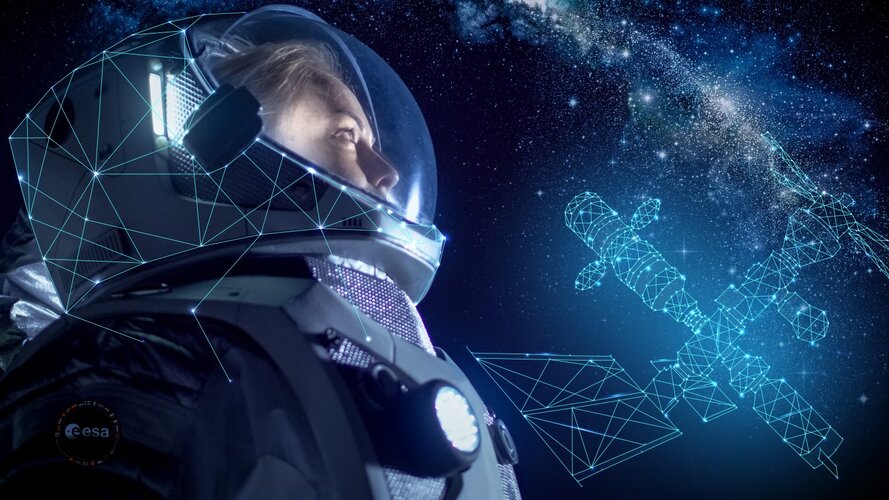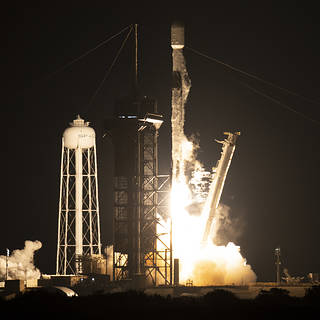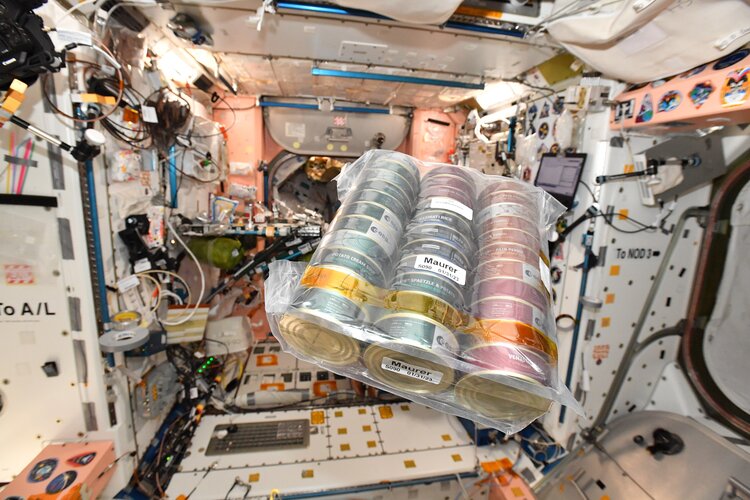
Copernical Team
Thursday, 09 December 2021 12:13
China's lunar rover spots cube-like object on Moon, sparking curiosity
Beijing (XNA) Dec 08, 2021
 The cube-like object spotted recently by China's lunar rover on the far side of the moon aroused wild curiosity in cyberspace worldwide this week.
Yutu 2, the lander and rover of the Chang'e 4 probe, captured an obscure but intriguing image about 80 meters from its location during the mission's 36th lunar day, according to Our Space, a Chinese science channel that published the machine's l
The cube-like object spotted recently by China's lunar rover on the far side of the moon aroused wild curiosity in cyberspace worldwide this week.
Yutu 2, the lander and rover of the Chang'e 4 probe, captured an obscure but intriguing image about 80 meters from its location during the mission's 36th lunar day, according to Our Space, a Chinese science channel that published the machine's l
 The cube-like object spotted recently by China's lunar rover on the far side of the moon aroused wild curiosity in cyberspace worldwide this week.
Yutu 2, the lander and rover of the Chang'e 4 probe, captured an obscure but intriguing image about 80 meters from its location during the mission's 36th lunar day, according to Our Space, a Chinese science channel that published the machine's l
The cube-like object spotted recently by China's lunar rover on the far side of the moon aroused wild curiosity in cyberspace worldwide this week.
Yutu 2, the lander and rover of the Chang'e 4 probe, captured an obscure but intriguing image about 80 meters from its location during the mission's 36th lunar day, according to Our Space, a Chinese science channel that published the machine's l
Published in
News
Tagged under
Thursday, 09 December 2021 12:13
NASA Returns Hubble to Full Science Operations
Washington DC (SPX) Dec 08, 2021
 NASA's Hubble Space Telescope team recovered the Space Telescope Imaging Spectrograph on Monday, Dec. 6, and is now operating with all four active instruments collecting science. The team has still not detected any further synchronization message issues since monitoring began Nov. 1.
The team will continue work on developing and testing changes to instrument software that would allow them
NASA's Hubble Space Telescope team recovered the Space Telescope Imaging Spectrograph on Monday, Dec. 6, and is now operating with all four active instruments collecting science. The team has still not detected any further synchronization message issues since monitoring began Nov. 1.
The team will continue work on developing and testing changes to instrument software that would allow them
 NASA's Hubble Space Telescope team recovered the Space Telescope Imaging Spectrograph on Monday, Dec. 6, and is now operating with all four active instruments collecting science. The team has still not detected any further synchronization message issues since monitoring began Nov. 1.
The team will continue work on developing and testing changes to instrument software that would allow them
NASA's Hubble Space Telescope team recovered the Space Telescope Imaging Spectrograph on Monday, Dec. 6, and is now operating with all four active instruments collecting science. The team has still not detected any further synchronization message issues since monitoring began Nov. 1.
The team will continue work on developing and testing changes to instrument software that would allow them
Published in
News
Tagged under
Thursday, 09 December 2021 12:13
LCO Scientists Confirm the Discovery of the First Moving Microlensing Arcs
Goleta CA (SPX) Dec 09, 2021
 On April 18, 2019, the European Space Agency's Gaia Mission alerted astronomers worldwide to an unusually bright but fleeting celestial event: the gravitational microlensing event Gaia19bld. The temporary, chance alignment between two unrelated star systems produced twin images of the background star and gave scientists their first opportunity to actually observe the arc-shaped images move in re
On April 18, 2019, the European Space Agency's Gaia Mission alerted astronomers worldwide to an unusually bright but fleeting celestial event: the gravitational microlensing event Gaia19bld. The temporary, chance alignment between two unrelated star systems produced twin images of the background star and gave scientists their first opportunity to actually observe the arc-shaped images move in re
 On April 18, 2019, the European Space Agency's Gaia Mission alerted astronomers worldwide to an unusually bright but fleeting celestial event: the gravitational microlensing event Gaia19bld. The temporary, chance alignment between two unrelated star systems produced twin images of the background star and gave scientists their first opportunity to actually observe the arc-shaped images move in re
On April 18, 2019, the European Space Agency's Gaia Mission alerted astronomers worldwide to an unusually bright but fleeting celestial event: the gravitational microlensing event Gaia19bld. The temporary, chance alignment between two unrelated star systems produced twin images of the background star and gave scientists their first opportunity to actually observe the arc-shaped images move in re
Published in
News
Tagged under
Thursday, 09 December 2021 12:13
First crew of space station provide a full update on China's progress
Beijing (XNA) Dec 08, 2021
 The three astronauts involved in the Shenzhou XII mission have recovered well after their 3-month spaceflight and will return to regular training once related health assessments are completed.
Major General Jing Haipeng, another astronaut, said on Tuesday the post-spaceflight recovery period has three phases: isolation, convalescence and observation.
The three Shenzhou XII astronauts
The three astronauts involved in the Shenzhou XII mission have recovered well after their 3-month spaceflight and will return to regular training once related health assessments are completed.
Major General Jing Haipeng, another astronaut, said on Tuesday the post-spaceflight recovery period has three phases: isolation, convalescence and observation.
The three Shenzhou XII astronauts
 The three astronauts involved in the Shenzhou XII mission have recovered well after their 3-month spaceflight and will return to regular training once related health assessments are completed.
Major General Jing Haipeng, another astronaut, said on Tuesday the post-spaceflight recovery period has three phases: isolation, convalescence and observation.
The three Shenzhou XII astronauts
The three astronauts involved in the Shenzhou XII mission have recovered well after their 3-month spaceflight and will return to regular training once related health assessments are completed.
Major General Jing Haipeng, another astronaut, said on Tuesday the post-spaceflight recovery period has three phases: isolation, convalescence and observation.
The three Shenzhou XII astronauts
Published in
News
Tagged under
Thursday, 09 December 2021 12:13
US Army tests multi-orbit solutions leveraging MEO capabilities amid SES's upcoming O3b mPOWER launch
Reston VA (SPX) Dec 08, 2021
 SES Government Solutions (SES GS), a wholly-owned subsidiary of SES, supports the U.S. Army in conducting a series of cutting-edge trials and testing of commercial satellite constellations in multiple orbits, as well as services and ground terminals, in the U.S. Government's effort to establish Multi-Domain Operations (MDO) by 2028.
Most recently, the U.S. Army announced its integrated gro
SES Government Solutions (SES GS), a wholly-owned subsidiary of SES, supports the U.S. Army in conducting a series of cutting-edge trials and testing of commercial satellite constellations in multiple orbits, as well as services and ground terminals, in the U.S. Government's effort to establish Multi-Domain Operations (MDO) by 2028.
Most recently, the U.S. Army announced its integrated gro
 SES Government Solutions (SES GS), a wholly-owned subsidiary of SES, supports the U.S. Army in conducting a series of cutting-edge trials and testing of commercial satellite constellations in multiple orbits, as well as services and ground terminals, in the U.S. Government's effort to establish Multi-Domain Operations (MDO) by 2028.
Most recently, the U.S. Army announced its integrated gro
SES Government Solutions (SES GS), a wholly-owned subsidiary of SES, supports the U.S. Army in conducting a series of cutting-edge trials and testing of commercial satellite constellations in multiple orbits, as well as services and ground terminals, in the U.S. Government's effort to establish Multi-Domain Operations (MDO) by 2028.
Most recently, the U.S. Army announced its integrated gro
Published in
News
Tagged under
Thursday, 09 December 2021 12:13
Space Force mission blasts off from Florida after multiple delays
Washington DC (UPI) Dec 7, 2021
 A mission overseen by the U.S. Space Force to send equipment into space aboard an Atlas V rocket lifted off from Florida early Tuesday after a delay of several days.
United Launch Alliance sent the Space Test Program-3 (STP-3) mission into space from Launch Complex 41 at the Cape Canaveral Space Force Station in Florida at about 5:19 a.m. EST Tuesday.
The mission lifted off carry
A mission overseen by the U.S. Space Force to send equipment into space aboard an Atlas V rocket lifted off from Florida early Tuesday after a delay of several days.
United Launch Alliance sent the Space Test Program-3 (STP-3) mission into space from Launch Complex 41 at the Cape Canaveral Space Force Station in Florida at about 5:19 a.m. EST Tuesday.
The mission lifted off carry
 A mission overseen by the U.S. Space Force to send equipment into space aboard an Atlas V rocket lifted off from Florida early Tuesday after a delay of several days.
United Launch Alliance sent the Space Test Program-3 (STP-3) mission into space from Launch Complex 41 at the Cape Canaveral Space Force Station in Florida at about 5:19 a.m. EST Tuesday.
The mission lifted off carry
A mission overseen by the U.S. Space Force to send equipment into space aboard an Atlas V rocket lifted off from Florida early Tuesday after a delay of several days.
United Launch Alliance sent the Space Test Program-3 (STP-3) mission into space from Launch Complex 41 at the Cape Canaveral Space Force Station in Florida at about 5:19 a.m. EST Tuesday.
The mission lifted off carry
Published in
News
Tagged under
Thursday, 09 December 2021 12:13
Oculus Observatory set to disrupt space situational awareness globally
Adelaide, Australia (SPX) Dec 09, 2021
 The 'Oculus Observatory' is a new kind of space observatory, designed, built, and managed by Silentium Defence, which delivers the widest field of view, and the most cost-effective monitoring of objects in orbit, anywhere in the world.
Opened today, by Head of the Australian Space Agency, Enrico Palermo, 'Oculus' is located on the fringe of South Australia's dark sky reserve in the Mid-Mur
The 'Oculus Observatory' is a new kind of space observatory, designed, built, and managed by Silentium Defence, which delivers the widest field of view, and the most cost-effective monitoring of objects in orbit, anywhere in the world.
Opened today, by Head of the Australian Space Agency, Enrico Palermo, 'Oculus' is located on the fringe of South Australia's dark sky reserve in the Mid-Mur
 The 'Oculus Observatory' is a new kind of space observatory, designed, built, and managed by Silentium Defence, which delivers the widest field of view, and the most cost-effective monitoring of objects in orbit, anywhere in the world.
Opened today, by Head of the Australian Space Agency, Enrico Palermo, 'Oculus' is located on the fringe of South Australia's dark sky reserve in the Mid-Mur
The 'Oculus Observatory' is a new kind of space observatory, designed, built, and managed by Silentium Defence, which delivers the widest field of view, and the most cost-effective monitoring of objects in orbit, anywhere in the world.
Opened today, by Head of the Australian Space Agency, Enrico Palermo, 'Oculus' is located on the fringe of South Australia's dark sky reserve in the Mid-Mur
Published in
News
Tagged under
Thursday, 09 December 2021 11:02
Europe opens up a new space to commercial services

ESA is calling on industry to come forward with ideas for crew and cargo transportation, operations, payloads, research, living quarters and even astronaut training. All of this could develop into new services in an effort to enlarge the space ecosystem to the commercial sphere.
Published in
News
Tagged under
Thursday, 09 December 2021 05:16
NASA Launches New Mission to Explore Universe’s Most Dramatic Objects
 NASA’s Imaging X-ray Polarimetry Explorer (IXPE) mission launched at 1 a.m. EST Thursday on a SpaceX Falcon 9 rocket from NASA’s Kennedy Space Center in Florida.
NASA’s Imaging X-ray Polarimetry Explorer (IXPE) mission launched at 1 a.m. EST Thursday on a SpaceX Falcon 9 rocket from NASA’s Kennedy Space Center in Florida.
Published in
News
Tagged under
Wednesday, 08 December 2021 10:10
A Saarland space feast sprinkled with science

European food has always been out of this world, but this week ESA astronaut Matthias Maurer shared a taste of his home region, Saarland – with a serving of science – during a space-based Saint Nicholas feast.
Published in
News
Tagged under
